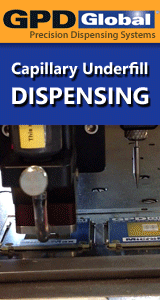Printed Circuit Board Assembly & PCB Design Forum
SMT electronics assembly manufacturing forum.
- SMTnet
- »
- Electronics Forum
- »
- Silver Sulphide Contamination of Resistors
Silver Sulphide Contamination of Resistors
![]() We have had a problem with some resistors on some conformall...
- Feb 21, 2001
by
Dave E
We have had a problem with some resistors on some conformall...
- Feb 21, 2001
by
Dave E
![]()
![]()
![]() References on corrosion are: * "ASM Corrosion Handbook No. ...
- Feb 21, 2001
by
davef
References on corrosion are: * "ASM Corrosion Handbook No. ...
- Feb 21, 2001
by
davef
![]()
![]()
![]() Realistically it seems like a component problem that the ven...
- Feb 21, 2001
by
Dave E
Realistically it seems like a component problem that the ven...
- Feb 21, 2001
by
Dave E
![]()
![]()
![]() I don't know where sulfur would get into your resistor suppl...
- Feb 21, 2001
by
davef
I don't know where sulfur would get into your resistor suppl...
- Feb 21, 2001
by
davef
![]()
![]()
![]() Well, the vendor claims the contaminant caused the component...
- Feb 21, 2001
by
Dave E
Well, the vendor claims the contaminant caused the component...
- Feb 21, 2001
by
Dave E
![]()
![]()
![]() I guess the answer to that would have something to do with t...
- Feb 22, 2001
by
davef
I guess the answer to that would have something to do with t...
- Feb 22, 2001
by
davef
![]()
![]()
![]() We still build a legacy product with a primitive backplane u...
- Feb 23, 2001
by
John Thorup
We still build a legacy product with a primitive backplane u...
- Feb 23, 2001
by
John Thorup
![]()
![]()
![]() >The sulphur outgassing from these rubber bands was
>enoug...
- Feb 23, 2001
by
Dave E
>The sulphur outgassing from these rubber bands was
>enoug...
- Feb 23, 2001
by
Dave E
![]()
![]()
![]() Well, here I am working Saturday. Seems my production Super...
- Feb 24, 2001
by
John Thorup
Well, here I am working Saturday. Seems my production Super...
- Feb 24, 2001
by
John Thorup
![]()
![]()
![]() ASTM E 443 is a test for sulfur by Oxygen Flask Combustion. ...
- Feb 26, 2001
by
blnorman
ASTM E 443 is a test for sulfur by Oxygen Flask Combustion. ...
- Feb 26, 2001
by
blnorman
![]()
Dave E
- SMTnet
- »
- Electronics Forum
- »
- Silver Sulphide Contamination of Resistors
.gif)






